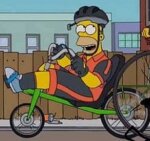NVRPA study on widening the W&OD at selected spots
Our Community › Forums › General Discussion › NVRPA study on widening the W&OD at selected spots
- This topic has 25 replies, 16 voices, and was last updated 8 years, 1 month ago by
DrP.
-
CreatorTopic
-
June 22, 2017 at 6:42 pm #919504
 lordofthemarkParticipant
lordofthemarkParticipant1. Wow. Even if only a study at this point, without identified funding, etc
2. What do you think of the benefits of the widening between EFC and Broad Street, the constraints on widening between EFC and Columbia Pike, and the relative merits of the two options?
3. How does Dave Cranor manage to find out about things that even some fairly obsessive NoVa bike advocates do not hear about?
-
CreatorTopic
-
AuthorReplies
-
June 22, 2017 at 7:12 pm #1072675
hozn
ParticipantIndeed, wow. That would be pretty awesome. I think in these parts the different transport modes would be enforced by the trail users well enough. Unlike, say, the Pinellas County Trail where there’s separation that seems to be entirely ignored by the trail users. After all, people learn to stand on the right side of the elevators here quickly enough and the trails aren’t frequented by tourists

I think the largest value would be widening between EFC and Broad Street, yes. With decreasing (but still significant) value all the way out to Vienna. West of Vienna there isn’t a ton of trail usage at this point save for small pockets out around Reston, Herndon. (I realize this study isn’t looking at feasibility for the whole trail, but it’s interesting to think about that being something that would be needed someday.)
I have no idea between EFC and Columbia Pike, as that’s not part of my commute.
June 22, 2017 at 9:14 pm #1072679 JuddParticipant
JuddParticipant@hozn 162088 wrote:
I have no idea between EFC and Columbia Pike, as that’s not part of my commute.
Use supports widening here too. Heavy mixed use. There are some spots where widening would be a bit more difficult given the surrounding geography.
June 22, 2017 at 10:29 pm #1072684mstone
ParticipantThis would be great around Reston and other spots where lunch walkers travel in packs
June 23, 2017 at 12:24 pm #1072695 chris_sParticipant
chris_sParticipant@lordofthemark 162084 wrote:
3. How does Dave Cranor manage to find out about things that even some fairly obsessive NoVa bike advocates do not hear about?
In this particular instance, he learned about it from my email to the Arlington BAC listserve and I learned about it because I’m the weird guy who reads the NOVAParks Board of Directors Meeting minutes.
 June 23, 2017 at 12:45 pm #1072697
June 23, 2017 at 12:45 pm #1072697 JuddParticipant
JuddParticipant@chris_s 162108 wrote:
In this particular instance, he learned about it from my email to the Arlington BAC listserve and I learned about it because I’m the weird guy who reads the NOVAParks Board of Directors Meeting minutes.

Somebody should give you some sort of bike advocate of the year award or something…
June 23, 2017 at 12:51 pm #1072698 chris_sParticipant
chris_sParticipant@Judd 162110 wrote:
Somebody should give you some sort of bike advocate of the year award or something…
It hangs proudly in my office, representing all of the plaque-making-prowess one expects from a Cycling Advocacy organization.
[ATTACH=CONFIG]15038[/ATTACH]June 23, 2017 at 1:16 pm #1072699 chris_sParticipant
chris_sParticipantFor anyone who’d like more detail, here is the actual report.
Figure 1 – Trail Level of Service
Figure 2 – Widening Feasibility and Constraints Map
Memo / ReportJune 23, 2017 at 1:58 pm #1072702 bentbike33Participant
bentbike33Participant@chris_s 162111 wrote:
It hangs proudly in my office, representing all of the plaque-making-prowess one expects from a Cycling Advocacy organization.
You should really be standing next to it so the true “plaque-making-prowess” may be fully appreciated, rather than have some people assume you just don’t know how to post photos right-side-up.
June 23, 2017 at 2:06 pm #1072703bobco85
ParticipantThis got me thinking of the wonderful improvements that were made just over a year ago to the Burke-Gilman Trail in Seattle on the University of Washington campus. Not only did they widen the trail, they also used asphalt for the bike portion and concrete for the pedestrian portion. It was very intuitive and nice. Here are 2 pics of the improvements:
[ATTACH=CONFIG]15039[/ATTACH][ATTACH=CONFIG]15040[/ATTACH]Also, having ridden on the Pinellas Trail in Florida many times, hozn is absolutely correct about pedestrians not always using the pedestrian path when the trail has separation. I think some of this might be due to the fact that the trail only has lines in certain places (usually near road crossings), while most of the trail is not lined at all. I think that people instinctively move to their right, which makes it awkward when the pedestrian “lane” is on one’s left. First pic shows lack of lines (don’t look at the bollards, Steve O!), and the second pic shows the separate bike/ped paths.
[ATTACH=CONFIG]15041[/ATTACH][ATTACH=CONFIG]15042[/ATTACH]Using these 2 examples, I think that a white stripe is not going to be sufficient for good separation. I think that actually paving the pedestrian portion with concrete or using a separate path like the bridle gravel trail on the W&OD in Reston would be best.
Another aspect to consider is how the modes of travel should be separated. While this study focuses on bike-ped separation, I think it would be useful to consider fast-slow user separation much like how we separate fast and slow traffic on roads using bike lanes. This way, bikes/joggers (fast users) would be separated from walkers/strollers/dogs (slow users).
June 23, 2017 at 2:23 pm #1072704dkel
Participant@bentbike33 162115 wrote:
You should really be standing next to it so the true “plaque-making-prowess” may be fully appreciated, rather than have some people assume you just don’t know how to post photos right-side-up.
No, I’m sure the plaque came that way and there’s no way to fix it.
June 23, 2017 at 5:48 pm #1072711 HenryKeymaster
HenryKeymaster@chris_s 162111 wrote:
It hangs proudly in my office, representing all of the plaque-making-prowess one expects from a Cycling Advocacy organization.
[ATTACH=CONFIG]15038[/ATTACH]The scary thing about that is the people who made the plaque probably adjust their own brakes, too.
June 23, 2017 at 6:40 pm #1072712Vicegrip
Participantand I almost did not click on this thread today……
 June 23, 2017 at 7:42 pm #1072716
June 23, 2017 at 7:42 pm #1072716 Steve OParticipant
Steve OParticipant@bentbike33 162115 wrote:
You should really be standing next to it so the true “plaque-making-prowess” may be fully appreciated, rather than have some people assume you just don’t know how to post photos right-side-up.
Observant people will note the shadow rather than making rash assumptions.
June 23, 2017 at 8:45 pm #1072719 JuddParticipantsteve o;162129 wrote:total stalkers will note the shadow rather than making rash assumptions.
JuddParticipantsteve o;162129 wrote:total stalkers will note the shadow rather than making rash assumptions.ftfy
June 24, 2017 at 4:02 pm #1072725consularrider
Participant@bobco85 162116 wrote:
This got me thinking of the wonderful improvements that were made just over a year ago to the Burke-Gilman Trail in Seattle on the University of Washington campus. Not only did they widen the trail, they also used asphalt for the bike portion and concrete for the pedestrian portion. It was very intuitive and nice. Here are 2 pics of the improvements:
[ATTACH=CONFIG]15039[/ATTACH][ATTACH=CONFIG]15040[/ATTACH]Also, having ridden on the Pinellas Trail in Florida many times, hozn is absolutely correct about pedestrians not always using the pedestrian path when the trail has separation. I think some of this might be due to the fact that the trail only has lines in certain places (usually near road crossings), while most of the trail is not lined at all. I think that people instinctively move to their right, which makes it awkward when the pedestrian “lane” is on one’s left. First pic shows lack of lines (don’t look at the bollards, Steve O!), and the second pic shows the separate bike/ped paths.
[ATTACH=CONFIG]15041[/ATTACH][ATTACH=CONFIG]15042[/ATTACH]Using these 2 examples, I think that a white stripe is not going to be sufficient for good separation. I think that actually paving the pedestrian portion with concrete or using a separate path like the bridle gravel trail on the W&OD in Reston would be best.
Another aspect to consider is how the modes of travel should be separated. While this study focuses on bike-ped separation, I think it would be useful to consider fast-slow user separation much like how we separate fast and slow traffic on roads using bike lanes. This way, bikes/joggers (fast users) would be separated from walkers/strollers/dogs (slow users).
Just quick observation, one of the points made in discussions of runners in bike lanes is that frequently runners prefer asphalt to concrete because of the perception that it is easier on the joints.
-
AuthorReplies
- You must be logged in to reply to this topic.